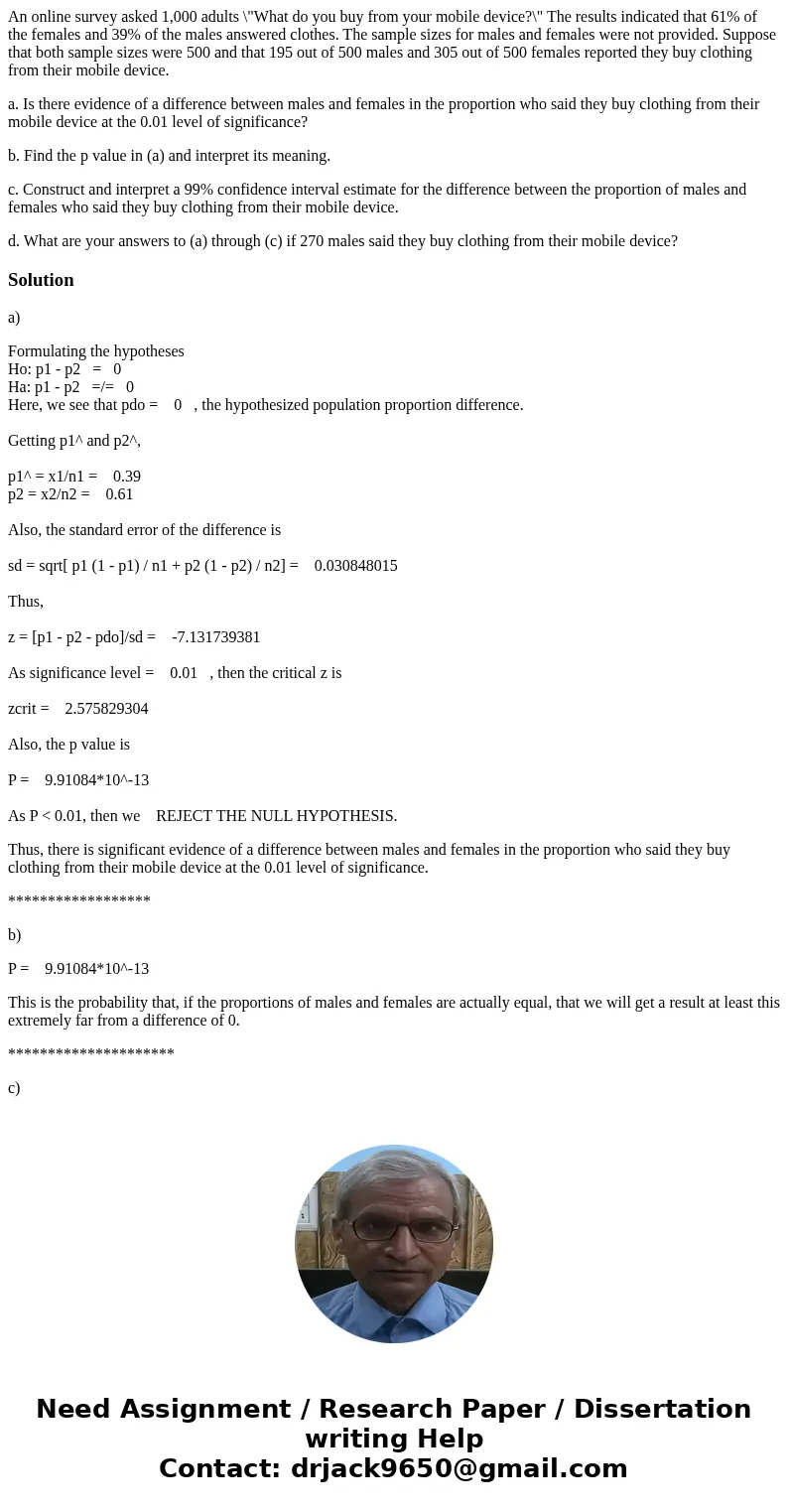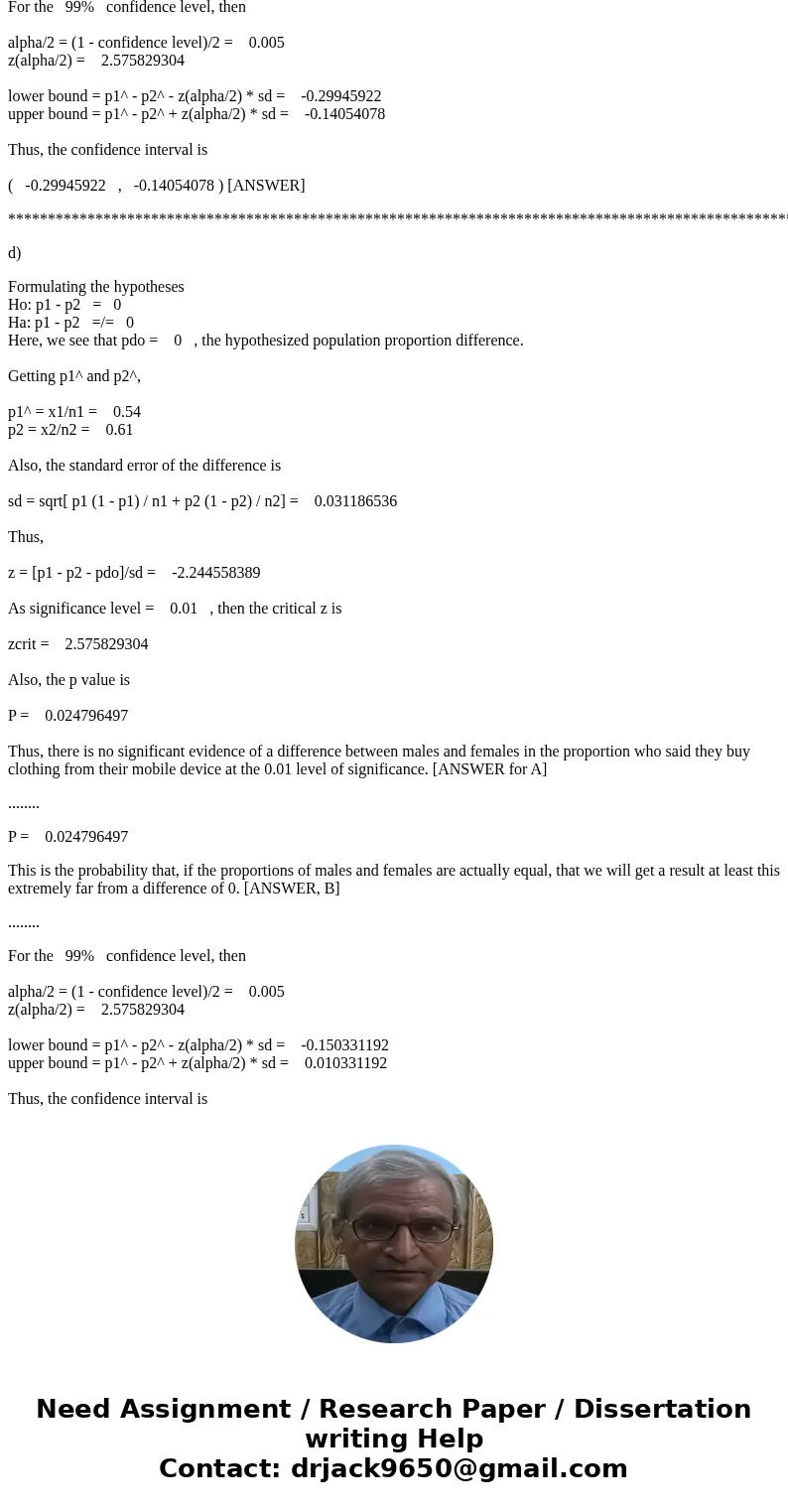An online survey asked 1000 adults What do you buy from your
An online survey asked 1,000 adults \"What do you buy from your mobile device?\" The results indicated that 61% of the females and 39% of the males answered clothes. The sample sizes for males and females were not provided. Suppose that both sample sizes were 500 and that 195 out of 500 males and 305 out of 500 females reported they buy clothing from their mobile device.
a. Is there evidence of a difference between males and females in the proportion who said they buy clothing from their mobile device at the 0.01 level of significance?
b. Find the p value in (a) and interpret its meaning.
c. Construct and interpret a 99% confidence interval estimate for the difference between the proportion of males and females who said they buy clothing from their mobile device.
d. What are your answers to (a) through (c) if 270 males said they buy clothing from their mobile device?
Solution
a)
Formulating the hypotheses
Ho: p1 - p2 = 0
Ha: p1 - p2 =/= 0
Here, we see that pdo = 0 , the hypothesized population proportion difference.
Getting p1^ and p2^,
p1^ = x1/n1 = 0.39
p2 = x2/n2 = 0.61
Also, the standard error of the difference is
sd = sqrt[ p1 (1 - p1) / n1 + p2 (1 - p2) / n2] = 0.030848015
Thus,
z = [p1 - p2 - pdo]/sd = -7.131739381
As significance level = 0.01 , then the critical z is
zcrit = 2.575829304
Also, the p value is
P = 9.91084*10^-13
As P < 0.01, then we REJECT THE NULL HYPOTHESIS.
Thus, there is significant evidence of a difference between males and females in the proportion who said they buy clothing from their mobile device at the 0.01 level of significance.
******************
b)
P = 9.91084*10^-13
This is the probability that, if the proportions of males and females are actually equal, that we will get a result at least this extremely far from a difference of 0.
*********************
c)
For the 99% confidence level, then
alpha/2 = (1 - confidence level)/2 = 0.005
z(alpha/2) = 2.575829304
lower bound = p1^ - p2^ - z(alpha/2) * sd = -0.29945922
upper bound = p1^ - p2^ + z(alpha/2) * sd = -0.14054078
Thus, the confidence interval is
( -0.29945922 , -0.14054078 ) [ANSWER]
**************************************************************************************************************************************************************************************************************************************************************************
d)
Formulating the hypotheses
Ho: p1 - p2 = 0
Ha: p1 - p2 =/= 0
Here, we see that pdo = 0 , the hypothesized population proportion difference.
Getting p1^ and p2^,
p1^ = x1/n1 = 0.54
p2 = x2/n2 = 0.61
Also, the standard error of the difference is
sd = sqrt[ p1 (1 - p1) / n1 + p2 (1 - p2) / n2] = 0.031186536
Thus,
z = [p1 - p2 - pdo]/sd = -2.244558389
As significance level = 0.01 , then the critical z is
zcrit = 2.575829304
Also, the p value is
P = 0.024796497
Thus, there is no significant evidence of a difference between males and females in the proportion who said they buy clothing from their mobile device at the 0.01 level of significance. [ANSWER for A]
........
P = 0.024796497
This is the probability that, if the proportions of males and females are actually equal, that we will get a result at least this extremely far from a difference of 0. [ANSWER, B]
........
For the 99% confidence level, then
alpha/2 = (1 - confidence level)/2 = 0.005
z(alpha/2) = 2.575829304
lower bound = p1^ - p2^ - z(alpha/2) * sd = -0.150331192
upper bound = p1^ - p2^ + z(alpha/2) * sd = 0.010331192
Thus, the confidence interval is
( -0.150331192 , 0.010331192 ) [ANSWER, C]



 Homework Sourse
Homework Sourse